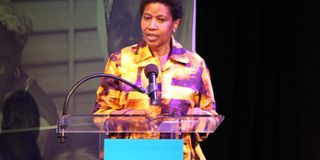Covid-19 has pushed more women into poverty, reveals UN Women

Phumzile Mlambo-Ngcuka, the UN Women Executive Director says we must use the Covid-19 crisis as an opportunity to direct attention and resources to empower rural women and eliminate the long-standing obstacles to their progress.
What you need to know:
- This year, around 435 million women and girls will be living in extreme poverty on less than $1.90 a day including 47 million pushed into poverty as a result of Covid-19.
- G7 leaders urged to explicitly recognise this and ensure that their Covid-19 response intentionally, strongly and permanently redresses these long-standing inequalities.
- About 59 per cent of the world’s poor women currently live in sub-Saharan Africa
The Covid-19 pandemic has seen an increase in poverty rates for women by 9.1 per cent globally, UN-Women has revealed.
UN-Women Executive Director Phumzile Mlambo-Ngcuka, in a statement, noted that the pandemic has amplified existing gender inequalities in the societies, exposing millions of women to increased risk of infection, violence, economic devastation and poverty, and threatening to reverse hard-won progress for gender equality.
The UN-Women Chief observed that women earn less, save less, hold less secure jobs and are more likely to work in the informal sector with fewer social protections.
According to the agency, by 2021, around 435 million women and girls will be living in extreme poverty on less than $1.90 a day including 47 million pushed into poverty as a result of Covid-19.
She noted that closures and the pandemic mitigation measures have stopped women from earning, especially affecting the 740 million women globally with informal and precarious jobs that largely underpin the local economy.
“Overall, women’s employment is 19 per cent more at risk than men’s, and while the pandemic will impact global poverty generally, women of reproductive age are disproportionately affected,” she said.
Stimulus programmes
She called on the G7 leaders to explicitly recognise this and ensure that their Covid-19 response intentionally, strongly and permanently redresses these long-standing inequalities.
“Fiscal stimulus programmes must be targeted to women, for example, by expanding the reach and benefit levels of social assistance programs such as cash transfers and social pensions,” she added.
The organisation also rooted for women in the informal economy to be supported to access cash transfers or unemployment compensation, especially those without access to banking.
Bailouts and support measures, the agency noted, should include micro and small businesses, where women entrepreneurs are relatively more represented, with tax breaks for women-owned businesses and support for women’s businesses in supply chain.
In September last year, latest poverty forecasts by UN-Women and UNDP released poverty forecasts that showed there will be a sharp increase of female poverty worldwide due to the effects of Covid-19 pandemic.
UN Women in a press release indicated that the poverty forecast project had lifted the lid on how the Covid-19 pandemic has unleashed a serious reversal effect of female economic development across the globe.
The organisation added the poverty forecast shows the pandemic has confined more women and girls to poverty than men with 47 million women worldwide sliding to poverty as a result of the crisis which started early this year.
Most vulnerable
The poverty forecast observed that there will be 119 poor women for every 100 poor men aged 25-34 years a ration that is expected to increase to 121 women per 100 men by 2030.
It also indicated that unless measures are taken to shield the most vulnerable, by September this year, 435 million women and girls will be living on less than $1.90 a day worldwide including 47 million specifically impoverished by Covid-19.
“The increases in women’s extreme poverty are a stark indictment of deep flaws in the ways we have constructed our societies and economies. We know that women take most of the responsibility for caring for the family; they earn less, save less and hold much less secure jobs – in fact, overall, women’s employment is 19 per cent more at risk than men’s, ” Ms Ngcuka.
The poverty forecast project which was commissioned by UN Women and UNDP, and carried out by the Pardee Centre for International Futures at the University of Denver, showed that while the pandemic will impact global poverty generally, women will be disproportionately affected, especially women of reproductive age.
The data, summarised in a UN Women report from Insights to Action: Gender Equality in the wake of Covid-19, also show that the pandemic will push 96 million people into extreme poverty by 2021, 47 million of whom are women and girls. This will increase the total number of women and girls living in extreme poverty to 435 million, with projections showing that this number will not revert to pre-pandemic levels until 2030.
About 59 per cent of the world’s poor women currently live in sub-Saharan Africa. The new poverty forecasts showed a rise of about 9.1 percent in female poverty due to the Covid-19 pandemic.





